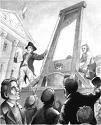
Peak of the Guillotine
From 1792 to 1795 the Guillotine reigned supreme in France. It was soaked into every aspect of life in culture, especially in Paris. There was everything from songs to comic books with the topic of the Guillotine. A Guillotine soon became a standard prop in marionette theaters. Beauty salons would make miniature guillotines that were often brought to the dinner table to slice bread or fruit. Even more ridiculous, little dolls resembling someones' enemy would be decapitated at an evening dessert!
Living Heads
It is now known that the Guillotine was not the democratic, painless, and humane machine it was set out to be. There is a medical controversy on whether or not victims were killed instantly. It is possible that the nerves in a victims take two to three minutes to be fully deceased after decapitation. When an executioner at a public Parisian execution slapped the cheek of Charlotte Corday's severed head, the crowd said that both cheeks reddened. It has also been told by many people of the era that the eyes on a severed head follow a person when speaking. In 1905, a doctor named Mr. Beaurieux addressed the head of an executed prisoner by calling out his name,"Languille". After the call, the head responded by opening its eyelids and staring at the doctor. After a while, Dr. Beaurieux called out the victims' name a second time. The eyelids then focused at the doctor in a penetrating and slightly annoyed manner. The heads' mouth moved slightly, as if it was trying to speak. However, the severed head failed to respond to the Doctors' third call.
Anarchists Confront Guillotine
By the time the Guillotine reached its peak, there was a strong counter movement. Around 1870, a large execution was the last to be public. From then on, it was a law that all executions had to take place in La Sante prison. In the 1890's, mainstream France had a very strong fear of terrorism. There was a wide gap between wealth and poverty, without a middle class in between. Many anarchists emerged and started terrorist attacks to bring attention to this situation and the use of the Guillotine. From 1892 to 1894 a series of bomb attacks brought Paris into terror. Everything from buses to homes to theaters were deserted. At the same time, however, anarchists became viewed as fashionable by intellectuals. Four terrorists were put to death during the most publicised trial in France.
The Nazi Guillotine
Although the Guillotine is known for its frequent use in France, it was also a common execution by the Nazis. According to the Nazis themselves, there was over 16,500 executions by Guillotine between 1933 and 1945. Around 1944 the Nazis used the Guillotine even more frequently. During this time, Hitler ordered an additional 20 machines and began recruiting more executioners. In a ten month period between 1944 and 1945, over 10,000 heads fell. At the execution camp in Plontzensee, 70 Jewish prisoners were executed in a single night! The most significant executioners was Johann Baptist Reichart. He served as a prime executioner before, during, and after the Nazi regime. It is said that he has guillotined 2,876 people, more than any other executioner. Even more amazing, Reichart guillotined 1,399 people in the year of 1944,. This is an average of four victims per day!
Guillotine Abroad and Outdated
The Guillotine went wherever the revolutionary armies brought french culture. It was introduced to the West Indies and Belgium, and was also frequently used in Northern Italy and Greece. Even though it was used abroad, it was hated by the general public. When mass executions ceased, people would celebrate in the streets. People sang and danced to forget about the past of executions. In Paris, a Ball was held every night.
After World War 1, the Guillotine had grown antique.The horse-drawn wagon, kerosene lanterns, and bran to absorb the blood were all outdated in twentieth century technology. Attendance at executions in prisons dropped dramatically. A prisoner named Claude Buffet was a prisoner who had an execution tactic. The executioner was to say "its your pardon" before the knife drops, so the prisoner will die in a state of joy. Ironically, Claude Buffet was executed later on.
Ending of the Guillotine
A double execution in1972 was not the last execution in France, but it was the last to take place in Paris. The last execution by Guillotine took place on September 10, 1977 in Marseilles, France. The Prisoner was Hamiba Djanboubi, a Tunisian immigrant condemned of murder. In September of 1981, a man named Robert Badinter proposed a motion for the abolition of the death penalty in France. The motion was soon passed. The blade of the guillotine hasn't fallen since.
The Guillotine reigned for almost 200 years. It killed everybody from local peasants convicted of stealing to the king of France.It started as a symbol of democracy and equality to a symbol of evil and destruction. The Guillotine arguably has a bigger legacy than any other way to die.

No comments:
Post a Comment